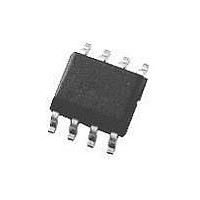FM25CL64-G Ramtron, FM25CL64-G Datasheet - Page 7

FM25CL64-G
Manufacturer Part Number
FM25CL64-G
Description
IC, FRAM, 64KBIT, 20MHZ, SOIC-8
Manufacturer
Ramtron
Datasheet
1.FM25CL64-G.pdf
(14 pages)
Specifications of FM25CL64-G
Memory Size
64Kbit
Memory Configuration
8K X 8
Ic Interface Type
Serial, SPI
Supply Voltage Range
2.7V To 3.65V
Memory Case Style
SOIC
No. Of Pins
8
Operating Temperature Range
-40°C To +85°C
Lead Free Status / RoHS Status
Lead free / RoHS Compliant
Available stocks
Company
Part Number
Manufacturer
Quantity
Price
Company:
Part Number:
FM25CL64-G
Manufacturer:
IDT
Quantity:
31 000
Part Number:
FM25CL64-G
Manufacturer:
RAMTRON
Quantity:
20 000
Company:
Part Number:
FM25CL64-G
Manufacturer:
RAMTRON
Quantity:
18 544
The BP1 and BP0 bits and the Write Enable Latch
are the only mechanisms that protect the memory
from writes. The remaining write protection features
protect inadvertent changes to the block protect bits.
The WPEN bit controls the effect of the hardware
/WP pin. When WPEN is low, the /WP pin is
ignored. When WPEN is high, the /WP pin controls
write access to the Status Register. Thus the Status
Register is write protected if WPEN=1 and /WP=0.
Table 4. Write Protection
Memory Operation
The SPI interface, which is capable of a relatively
high clock frequency, highlights the fast write
capability of the F-RAM technology. Unlike SPI-bus
EEPROMs, the FM25CL64 can perform sequential
writes at bus speed. No page register is needed and
any number of sequential writes may be performed.
Write Operation
All writes to the memory begin with a WREN op-
code with /CS being asserted and deasserted. The
next op-code is WRITE. The WRITE op-code is
followed by a two-byte address value. The upper 3-
bits of the address are ignored. In total, the 13-bits
specify the address of the first data byte of the write
operation. This is the starting address of the first data
byte of the write operation. Subsequent bytes are data
bytes, which are written sequentially. Addresses are
incremented internally as long as the bus master
continues to issue clocks and keeps /CS low. If the
last address of 1FFFh is reached, the counter will roll
over to 0000h. Data is written MSB first. The rising
edge of /CS terminates a WRITE operation. A write
operation is shown in Figure 9.
EEPROMs use page buffers to increase their write
throughput. This compensates for the technology’s
inherently slow write operations. F-RAM memories
do not have page buffers because each byte is written
to the F-RAM array immediately after it is clocked in
Rev. 3.5
Feb. 2011
WEL
0
1
1
1
WPEN
X
0
1
1
/WP
X
X
0
1
Protected Blocks
Protected
Protected
Protected
Protected
This scheme provides a write protection mechanism,
which can prevent software from writing the memory
under any circumstances. This occurs if the BP1 and
BP0 are set to 1, the WPEN bit is set to 1, and /WP is
set to 0. This occurs because the block protect bits
prevent writing memory and the /WP signal in
hardware prevents altering the block protect bits (if
WPEN is high). Therefore in this condition, hardware
must be involved in allowing a write operation. The
following table summarizes the write protection
conditions.
(after the 8
to be written without page buffer delays.
Read Operation
After the falling edge of /CS, the bus master can issue
a READ op-code. Following the READ command is
a two-byte address value. The upper 3-bits of the
address are ignored. In total, the 13-bits specify the
address of the first byte of the read operation. This is
the starting address of the first byte of the read
operation. After the op-code and address are issued,
the device drives out the read data on the next 8
clocks. The SI input is ignored during read data
bytes. Subsequent bytes are data bytes, which are
read out sequentially. Addresses are incremented
internally as long as the bus master continues to issue
clocks and /CS is low. If the last address of 1FFFh is
reached, the counter will roll over to 0000h. Data is
read MSB first. The rising edge of /CS terminates a
READ operation.
Figure 10.
Hold
The /HOLD pin can be used to interrupt a serial
operation without aborting it. If the bus master pulls
the /HOLD pin low while SCK is low, the current
operation will pause. Taking the /HOLD pin high
while SCK is low will resume an operation. The
transitions of /HOLD must occur while SCK is low,
but the SCK pin can toggle during a hold state.
Unprotected Blocks
Protected
Unprotected
Unprotected
Unprotected
th
clock). This allows any number of bytes
A read operation is shown in
Status Register
Protected
Unprotected
Protected
Unprotected
FM25CL64
Page 7 of 14












